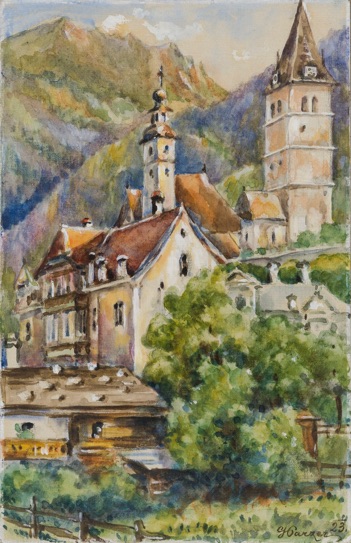
Watercolor, Gisela Parzer
The name Kitzbühel is generally associated with sports often inspired by the competition ethos: Hahnenkamm Races, tennis (Generali Open), Harley Davidson- and classic car parades, mountaineering, etc.
Almost unrecognised by international and native VIPs, there is a second, cultural main focus connected with the name Kitzbühel developing steadily: Concerts, theatrical performances, literary readings and musical Summer Academies turn the city of sports by and by into a cultural centre too.
Very soon, particularly during the previous decades, Tyrol has turned out to be one of the most important organ landscapes of Austria. Alone in the further and immediate vicinity exemplarily restored historic and excellent newly-built organs dominate the picture of this organ landscape.
Franz Schmidt’s complete works for organ which paved the way to the summit of his independence confirm – beside Max Reger – his rank as the most important ogan composer within the German-speaking area of the time after J.S. Bach and Felix Mendelssohn-Bartholdy.
During the last decades, the interest for the organ works of Franz Schmidt has been roused increasingly by the presence
of his organ works in concerts, numerous recordings on sound carriers, as well as by teaching and research.
The concept of the competition programme comprises various components. Firstly, it reflects the stylistic variety of organ music: from baroque, classical and romantic music up to Neoclassicism and Modernism, each style is represented by a number of composers.
In Franz Schmidt’s composing environment in Vienna, there can be observed a distinct, continuous stylistic development with Franz Schmidt in the centre: his teacher was Robert Fuchs, a representative of 19th century Romanticism in Austria, who is unjustifiedly almost forgotten. One of Franz Schmidt’s students, in respect of his music unmistakably related to his tutor, was Walter Bricht, whose “Variationen über ein Thema von Franz Schmidt” are included in the list of free-choice organ pieces for the 2nd Qualifying Round.
Besides their affinity to Franz Schmidt, the Austrian composers whose works are listed in the competition repertoire are linked by various ties. Johannes Brahms, Robert Fuchs and Joseph Marx were organ and composition teachers at the “Konservatorium der Gesellschaft der Musikfreunde” and later on at its successor institution, the “Staatsakademie für Musik und darstellende Kunst” (Academy of Music and the Performing Arts) in Vienna. Johann Nepomuk David, a native of Upper Austria and composition professor in Leipzig and Stuttgart, was one of early promoters of a new linear and austere composition style; while being composed in a romantic idiom, Franz Schmidt’s chorale preludes are, to a certain extent, related with David’s approach.
To include the work of a Tyrolean composer, Kurt Estermann, in the repertoire of the competition can be considered an explicit asset for an international organ competition taking place in one of the most famous Tyrolean cities.
Helga Scholz-Michelitsch
OPENING OF THE 5TH ORGAN COMPETITION 2014
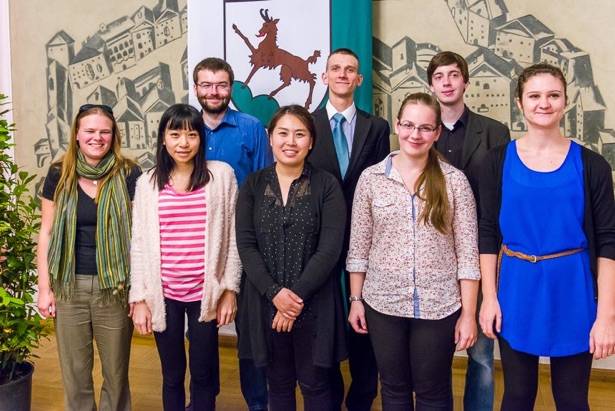
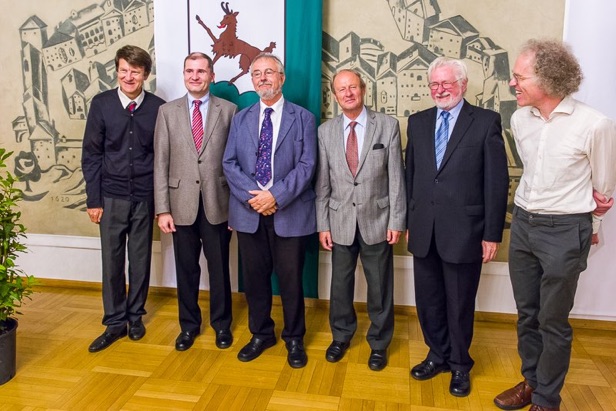
PRIZE WINNERS
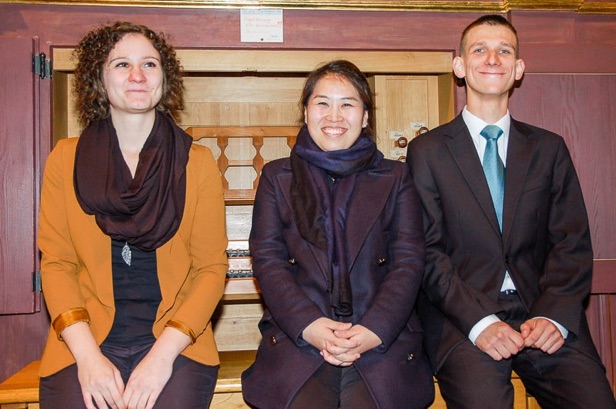
The prize winners of the 5th Internationalen Franz Schmidt organ competition in Kitzbühel:
No 1st prize
2nd prize Melissa Dermastia (University of Music Vienna)
2nd prize Yeonju Sarah Kim (University of Music Salzburg)
3rd prize Krysztof Weronowski-Ptaszynski (University of Music Vienna)
Special Award for the best interpretation of the work of Robert Fuchs: Melissa Dermastia, Austria
The competitors came from Austria, Poland, Russia, Germany, South Korea, Hungary, USA
AWARDS CEREMONY 2014
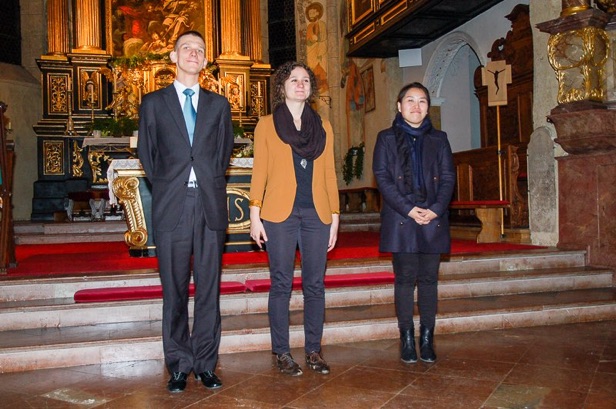
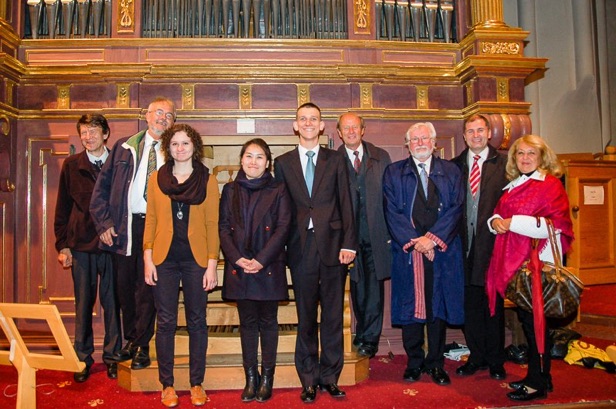
More pictures of the Awards Ceremony
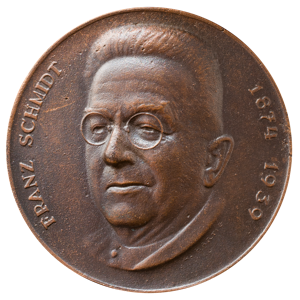
(Photo: Clemens Kneringer)
COMPETITION PROGRAMME
1st Qualifying Round (Kitzbühel)
a. J. S. Bach, Praeludium und Fuge G-Dur BWV 550 (not 541!)
b. J. S. Bach, Choralbearbeitung „Christus, der uns selig macht“ BWV 747
c. Franz Schmidt, Präludium und Fuge Es-Dur (aus „Vier kleine Präludien und
Fugen“)
2nd Qualifying Round (Hopfgarten)
a. Robert Fuchs, Variationen und Fuge über ein Originalthema
(Universal Edition UE 19553, „Wiener Hoforganisten“)
b. Johann Nepomuk David, Mit Fried und Freud fahr ich dahin
( Choralwerk III, Nr. 19)
c. Folgende Werke eines der angeführten Komponisten nach freier Wahl:
– Marco Enrico Bossi, Pastorale op. 118/3 and Toccata di concerto – Vivace
op. 118/5
– Johannes Brahms, Präludium und Fuge g-Moll and
Choralvorspiel „O Gott du frommer Gott“ aus op. 111
– Walter Bricht, Variationen über ein Thema von Franz Schmidt, op. 22
– Petr Eben, Hommage à Dietrich Buxtehude (1987)
– César Franck, Prière, op. 20 or Fantaisie A-Dur
– Paul Hindemith, Sonate II
– Joseph Marx, Toccata C-Dur
– Felix Mendelssohn-Bartholdy, Sonate f-Moll, op. 65/1
– Felix Mendelssohn-Bartholdy, Sonate B-Dur, op. 65/4
– Max Reger, Introduktion und Passacaglia d-Moll, o.O.
– Louis Vierne, Clair de lune, op. 53/5 and Finale aus der 1. Symphonie, op. 14
– Olivier Messiaen, 2. und 3. Satz („Alléluias…“ und „Transports…“) aus „L‘Ascension“
d. Franz Schmidt, Choralvorspiel „O wie selig seid ihr doch, ihr Frommen“
Finale (Kitzbühel)
a. Georg Muffat, Toccata V or VIII (aus „Apparatus musico-organisticus“)
b. Franz Schmidt, Toccata C-Dur
c. J. S. Bach, Toccata BWV 566 (E-Dur or C-Dur)
d. Kurt Estermann, A Fansye
JURY FOR THE COMPETITION
Helmut Binder, Österreich
István Ella, Ungarn
Joachim Grubich, Polen
Bernhard Haas, Deutschland
Peter Planyavsky, Österreich
Chairman: Karl-Gerhard Straßl, Austria
